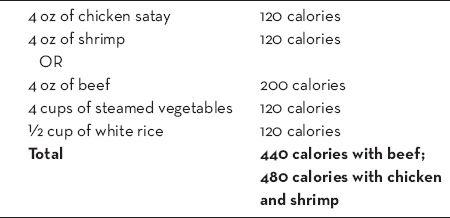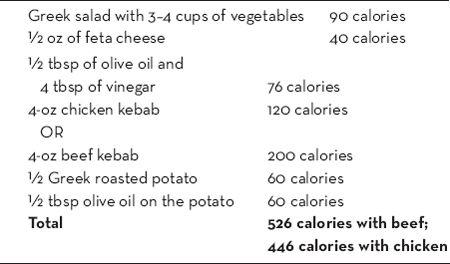The Petite Advantage Diet (23 page)
Read The Petite Advantage Diet Online
Authors: Jim Karas

This is
perfect
for your 1600-calorie-day dinner.
Petite busters:
Anything fried, like egg rolls and the majority of the chicken in many chicken dishes. Kung Pao chicken, the most popular dish eaten in Chinese restaurants, is sometimes as high as 1700 calories per container. Also, the brown sauce is made with cornstarch and other high-calorie Addies.
Kryptonite was to Superman what variety is to Petites’ desire to lose weight
.
The variety makes you “weak” when you need to stay “strong.” There are volumes of research that prove that
the more variety presented, the more you will eat. In a Chinese restaurant, it is common to order a bunch of different dishes at the table and then to sample. That is not what I urge you to do as a Petite, because your dish must be carefully selected and prepared and you don’t want to succumb to the “variety” issue
.
Thai Restaurants
Like Chinese restaurants, Thai restaurants limit your choices. But I find that you have more options in a Thai restaurant. Here is what I want you to order:

This is
perfect
for your 1600-calorie-day dinner.
Petite busters:
Pad Thai, the noodle dish made with peanuts, is packed with calories, possibly as high as 1600 for one container. Anything made with coconut milk is also extremely high in calories and dangerous, saturated fat. The chicken satay is a great appetizer, but you have to skip the peanut sauce. The chicken alone has great flavor.
Greek Restaurants
Ah, now we are talking about my people. I am Greek and was raised in a household that served a lot of Greek food. The difference between the food served in Greece and the American version of it is unbelievable. Here is what I want you to order in a Greek restaurant:

Again, a great dinner on your 1600-calorie day and also not bad if you cut a little of the oil for a 1100-calorie day.
Petite busters:
Anything cooked in phyllo dough. I remember my grandmother making these cheese triangles that taste amazing. She would roll out the dough, then, with an industrial paintbrush, slather the butter on before rolling it up in the cheese. Also, like Italian food, anything made in a pan and anything with béchamel sauce, which is übercaloric. Also, please pull the skin off the chicken, or any animal protein for that matter. Skin is a very toxic food that is not only loaded with fat, but all the wrong fat. Please always remove it; sometimes that is necessary in a Greek restaurant.
Sushi Restaurants
I treat sushi restaurants as a separate category, as I strongly recommend them for the combination of protein, carbs, and fat. Here is an ideal meal for you at dinner:

That’s eighteen pieces of sushi. It’s a lot of food. And if you like, you can substitute one of the rolls for sashimi, which is simply the raw fish without the rice or seaweed. I know the rice is white, but I find that, in a restaurant, most brown rice is prepared with butter anyway, which pumps the calories up. Also, since the white rice is eaten with the protein and seaweed, the “quick empty” nature of the white carb slows down. You should also know that the seaweed is
packed
with vitamins and nutrients. It’s an amazing anti-aging, anti-inflammatory food. I also really like the wasabi, as it also is packed with vitamins and nutrients and it tips satiety mechanisms, as do all spices. That is why sushi is generally a win-win choice.
Petite busters:
The soy sauce, even if it is of the low-sodium variety. Regular soy sauce has approximately 1005 mg of sodium per tablespoon. The low-sodium variety is 600 mg. FYI, you should not consume more than 1500 mg of sodium a day. That is why you have to be careful with the use of soy sauce. If you mix a little in with your wasabi, you will find that just a dash goes a long way. The other Petite buster is anything labeled “spicy,” as that generally means that it was prepared with mayonnaise, and we already talked about the danger of that when it comes to calories. I shouldn’t have to say it, but tempura and all the fried items at a sushi restaurant are also off-limits. Not only is fried food in general high in calories, but it frequently is also cooked in the “wrong” oils that are full of saturated fats and also inflame the body. Remember how the leaves falling into a pool can clog up the baby pool more than the big Olympic pool? Well, fried food isn’t just leaves falling into your baby pool. It’s the whole tree!
I’m sure you see the themes that prevail with all my recommendations. Clearly, all portions must be on the smaller side. Add to that the case study from the New York University dietitians regarding the calorie and fat counts in most restaurants, and you have to agree. Frequently, when it comes to weight loss, I urge people to look to the past, when the average American was far lighter than we are now. I remember eating out as a little boy and frequently ordering “The Petite” filet. It was smaller than the big filet, which I could never finish. I still order “The Petite” filet to this day. I hope you now realize that you should as well.
| CHAPTER | 7 | LIQUID CALORIES Public Enemy # 1 |
A
2007 study reported in
Obesity
magazine showed that the average American is consuming 21 percent of their daily caloric intake in liquids.
1
Did you know that the average teenager is consuming between 500 and 1000 calories in liquid each and every day? That’s a disaster for weight loss and is going to impact our teens negatively when they end up as obese, disease-ridden adults.
Studies by the Bloomberg School project that 75 percent of American adults will be overweight or obese by 2015 and they link liquid calories directly to the epidemic.
2
How’s that for pointing the finger
directly
at liquid calories?
Petites, liquid calories are
killing
your desire to lose weight. This is true for almost all people, but even
more true
for you, because those extra liquid calories are
not
causing you to eat less. By that, I mean that neither your brain nor your body says: “I just drank a 200-calorie glass of juice, so I should eat less.” Liquid calories are evil members of the Addies category and you know my feeling about them.
Here are two big reasons to avoid almost all liquid calories:
• Liquid calories do
not
tip satiety mechanisms.
• Liquid calories add up
very
quickly.
Numerous research studies have shown that calories consumed as liquid don’t register a feeling of fullness (satiety) the way solid calories do. Translation: Wake up and drink orange juice (something you should
never
do) and your body says, “Where’s the food?” Get up and eat an orange and your body says, “Thanks for the food.”
Dr. Richard Mattes of Purdue University is at the forefront of this issue. He has conducted experiments using the solid form of food versus the liquid form of food with the exact same amount of calories and the same percentage of protein, carbohydrates, and fat. He and his team conclusively show that liquid calorie consumption does not lead to a feeling of fullness the way solid food does. In lay terms, you don’t eat
or
drink; you eat
and
drink. And the calories you consume in liquid form do not have an impact on the amount of solids you chow down.
This is so important that I am going to reiterate it: When you eat a solid food, your body registers a certain feeling of fullness. When you consume the exact same food in liquid form (think eating watermelon versus drinking watermelon juice), your body does
not
register a feeling of fullness.
It is interesting to note that our American obesity epidemic coincided with both an increase in the size of servings of liquid calories (Big Gulp, anyone?) and the frequency with which we consume liquid calories (Starbucks all day, every day).
3
Are you one of these consumers? What does that tell you about your present body weight?
I will go so far as to say that if Petites would cease consuming liquid calories, they would immediately lose some weight. Possibly not
all
the weight they desire to lose, but they would make a significant dent.
Avoiding Liquid Calories
Almost every liquid calorie out there presents a danger, so let’s take them one at time.
Water Bearing Calories
This is my fifth book, and never once in the past did I have to mention “water” when I talked about the evil of liquid calories. Unfortunately, there are a tremendous number of so-called “water” products that contain calories, and not just a few; some of them contain a
lot
of calories. You need to read labels before you just grab a water from a cooler. It’s a shame you have to do that, but clearly someone is buying these waters or the stores wouldn’t stock them.
Sports Drinks
Sports drinks are generally between eight and ten calories an ounce. They are a true marketing sham, as you do
not
need to replace electrolytes, etc. when exercising. Unless you are in the fifth set at Wimbledon against one of the Williams sisters–if you should be so lucky (or unlucky, as those girls are really something on the court!)–you should not be drinking them. FYI, nor should your children. Act as if they don’t exist! It’s another example of a food or beverage company telling us we need something that our ancestors didn’t need in the past. I don’t recall cowgirls drinking Gatorade out on the range, do you?
Soda
Soda is approximately twelve calories an ounce. According to the American Beverage Association, the average American drinks nearly fifty-four gallons of soft drinks each year. That, for the record, is the equivalent of almost twelve extra pounds of weight (probably
all
fat) each and every year. Another research study indicates that drinking just one soda a day increases your chances of obesity by 27 percent.
4
That’s not a typo; just one soda a day increases your risk of obesity by 27 percent.
